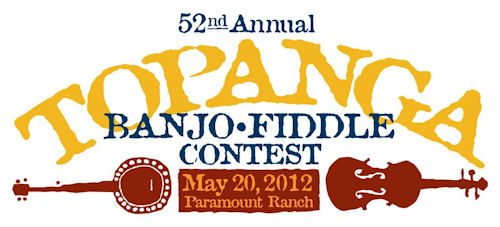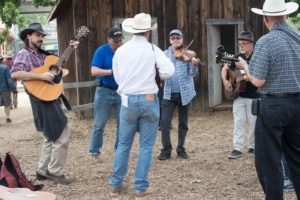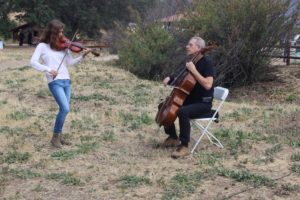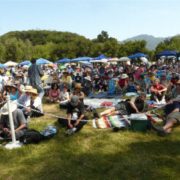Traditional Music Festivals Alive and Relevant?
Traditional Music Festivals Alive and Relevant?
The Topanga Banjo Fiddle Contest and Folk Festival (TBFC) started in 1961, making it one of the oldest continuously held traditional music events in the US. TBFC is now passed its 50th anniversary, whereas Clifftop, West Virginia (officially known as the Appalachian String Band Music Festival) is in its 23rd year; Winfield, Kansas (Walnut Valley Festival) is in its 41st year; and the National Old Time Fiddlers Contest in Weiser in Idaho started in its current form in 1963. Only the Old Fiddlers Convention in Galax, VA, marking its 78th event in 2013, has an unambiguously longer tradition.

What makes a festival relevant and gives it longevity? Most traditional music festivals or contests tend to be ephemeral events and are quickly forgotten, although some historic names get commercially revived. The Newport Folk Festival, for example, only lasted for about 10 festivals before its demise, but after was restarted in 1985 as a for-profit enterprise.
The Topanga Banjo Fiddle Contest is doing well, even if in human years it is past middle age: In 3 months, May 2013 will be its 53rd consecutive event (and 52nd anniversary). It added another contest stage last year and set a new attendance record the year before. Yet the present is never an indicator of the future. Without questioning what does and doesn’t work and trying to anticipate the future, it is easy for an event to become irrelevant and fade away. As one of the organizers of TBFC, this is something that concerns me. As David Bragger described in his recent column, the Old-Time Fiddler’s Convention and Festival in Goleta, appears to be struggling now (2010-2012). It was a very similar event to TBFC, but then a new organizer (Rotary) tried to turn it into a commercial festival with higher prices and a wider range of better known bands and in the process the festival lost its mission and core audience. It shriveled away rapidly rather than grew.

Topanga Banjo and Fiddle Festival jamming, no electric instruments anywhere!
Goleta was a spin-off of TBFC. In 1970, Los Angeles County prohibited outdoor festivals and TBFC moved to Santa Barbara for a year. After TBFC returned to LA, Peter Feldmann, who was a local organizer in Santa Barbara, founded the Goleta Old-Time Fiddler’s. He provides a fuller history in his blog.
While the format of TBFC and Goleta was identical for possibly 20 years, the two events have since developed very differently.
Here is my personal view of what I think is important to keep a relatively low budget festival alive.
First, it is important for a festival to have a unique identity, but it also needs to remain relevant over time. These are not contradictory aims. Relevance means keeping it interesting for future generations of musicians, something that teens would go to on their own, something that families with young children can enjoy, but it also is attractive to musicians (an important part of the atmosphere) and older people. Ticket price is important, to introduce people to new music, the entry barrier needs to be as low as possible and I think $20 as in 2012 is already a substantial barrier. Sure commercial festivals are much higher, but they are not festivals to create new audiences for traditional music. Many attendees at Topanga or Goleta come to play music themselves, not to listen to bands, and that is a substantial fraction of the revenue.
For a festival like TBFC or Goleta, there are three key ingredients:
– Scheduled performers/entertainment
– Contest
– General atmosphere, especially jamming, but also exhibits, demonstrations.
All three are important, lose any of the 3 and the event will shrink. TBFC stands on all three legs, cut one and it dies. Some big budget events (think Newport or Philadelphia Folk Festival) may get away by just focusing on scheduled performers, but it results in a completely different and, in my opinion, much less attractive approach: expensive concerts for passive audiences rather than participation; day ticket prices of $70-100 rather than $20; and big name performers even when that is closer to main stream charts (“Americana”) than traditional folk music. I doubt Newport is introducing audiences to new music, but rather following trends.
Scheduled Performers/Entertainment
I strongly believe that a festival needs a coherent theme to give the event a unique feel. A generic world music mash, including bands with electric instruments, is, well, generic. There are lots of those already and it sounds like any street fair organized by the Chamber of Commerce. Since TBFC has “banjo” and “fiddle” in the name, I look for some banjo and/or fiddle content among main stage bands. Doesn’t mean every band has to have it, but the large majority should and the remainder should be in a compatible style (e.g. folksinging; bluegrass bands that don’t have banjo or fiddle, etc.). The side stages move a bit further away and there are separate themes for “folk singing” or “cowboy music.” A demonstration/workshop that has some educational component is also preferable over “me and my buddies play our stuff”.
At TBFC, main stage bands play the same types of music that contestants play or that jammers play. And there are the same “no”s as well, which is absolutely no electric instruments and we don’t want any in the jam areas. That is less of “purity” than a practical issue because there used to be a serious problem with people bringing car batteries and amplifiers to start jam wars. That interfered with the contest and performances, so no electric instruments. Scheduled performers have to set a good example. But everybody is treated the same way and even Bob Dylan would have to leave his electric guitar at home. We wouldn’t pay him that much either: Currently, every slot on the side stage is $100, whether dance barn, a workshop, or a performance. More reimbursement for costs than a money-making opportunity.
I get a lot of complaints from bands about being too narrow-minded and too rigid – by every band with an electric guitar or bass, for example. But without having a coherent theme to the event, it just becomes too generic. At the same time, there are regular complaints about having too much “odd stuff” (but I am looking for roots music, it just doesn’t have to be from the Southeast US) and not enough bluegrass. So maybe it is the optimal middle.
Contest

Two contestants warming up at TBFC
TBFC splits stage times roughly equal between contest and performances, although there is a bit more time for the contest on the main stage. The contest is very important, but by itself has limited attractiveness to a general audience. Adding more scheduled performances has been a shift over the last decades. The growth of scheduled performances wasn’t at the expense of overall contest time, which itself has grown. But instead of having all contestants on the main stage (which in fact was a serious limitation because it restricted bands and beginners), we added playoffs that eliminated participation limits for bands, fiddles, and beginners on other stages. Having a dedicated beginner stage works well because that’s where beginners meet similar people and it is a much less threatening setting than the main stage. Just better for everybody, beginning contestants and paying audiences! And now there is enough room and time for 40 beginners rather than having to cap them. It creates headaches for the registrar, but it makes a better event. How to get participants is still a difficult story and I tried for years to get TBFC on the radar of school music teachers, with limited impact. A few fiddlers here and there come with their school arrangement of Boil the Cabbage or Mexican Hat Dance. So organizers will always be challenged to grow a contest on their own, it is out of their immediate control.
My take is that we want more people to participate. Let beginners play whatever they can play and when they are more experienced, anything that has some traditional roots is great. We want them to come back; soon they are going to be key participants in jams or even performers. It wasn’t that long that Chris Thile was a chubby faced little kid competing at Topanga whereas today’s teens look at him as an elder statesman (appropriately, of course, given that he is the recipient of a MacArthur grant and won several Grammy awards, including best folk album this year). And now that beginners are no longer on the main stage, maybe the quality in the advanced categories can increase again, especially bands.
General Atmosphere and Jamming
Finally, the atmosphere and that may be the most important part. Well, I have to say that at least until a few years ago, I preferred Goleta over Topanga because of better weather and less dust. In the last few years, I think TBFC worked better because despite less attractive weather and excessive crowds, it had energy. Better jamming, great music to listen to that is not on a stage.
At TBFC, there are many things that create the general atmosphere. There is the Western Town first of all and that itself is an attraction. Folk art demonstrations, people being dressed up in Western garb, participatory activities, including kids arts&crafts, dancing add a lot. But the central feature is jamming and busking. It requires that enough people who can play come and that there is enough room for them to find circles (the biggest enemy of that are excessively loud sound systems). It does help to have some scheduled beginner or led jams. So far there are enough active musicians, but keeping jamming alive is one of my concerns. It is too easily taken for granted, but it is anything but guaranteed. Already one of my worries is that there isn’t enough shady space these days and I personally think it would be good to move more vendors out of the town center. So far there is variety, circles for bluegrass, Irish, old-time, and the occasional classic-rock blues guys. Songmakers carve out their little area and sometimes also organizations like the Scottish Fiddlers of Los Angeles, California Bluegrass Association, Southwest Bluegrass Association. Several bands play their own stuff, pretty much busking, but it may look like jams to people walking around. We want the buskers to come and be part of the festival, but, no, I’m not looking for more “artists” to be put on the program. The composition does change over time and reflects changes in what is fashionable. Old-time used to be very small 10 years ago, but now seems to have grown to rival or even exceed the bluegrass jams.
Many musicians themselves only come for the jamming, they don’t care about scheduled bands or the contest. And they pay their own way (no, you won’t get free admission because you play in a band) and contribute hugely to the festival. You may find of the best musicians (sometimes even the most famous ones) in jams, not as scheduled performers. We cannot treat that aspect as an afterthought, it is at the core what makes TBFC the event it is. The jamming part is truly grass roots and cannot be organized, the best that can be done is to provide the space. Shady spots, near the center of the action so jammers can find their crowd, and yet away from sound systems. Like the contest, this aspect is much more easily damaged than rebuilt. There is a narrow path to navigate between financial sustainability, attractiveness to musicians who come for jamming/social aspects, general audience. But high ticket prices and loud sound systems would endanger this participation.
An event like TBFC or Goleta is not going to happen with a group of dedicated volunteers. And that group needs to stay relevant itself. It is unavoidable that enthusiasm fades over time and ideas get stale. New people are needed to join and bring fresh enthusiasm and energy. The organization of TBFC these days is a well oiled machine and we all know our tasks. But it won’t be long before an engine creaks and would fail without maintenance and replacement parts. Generational turnover is also important. Get in touch via the TBFC website if you want to become part of the TBFC team. Possibly any job is up for grabs, if you have strong connections in the traditional music scene – hey, I’ve done the talent coordinating almost for too long already and another 10 years would be way too long. I hope to turn this over within 5 years to a new generation.
Roland Sturm is Professor of Policy Analysis at the RAND Graduate School and usually writes on health policy, not music. He is the talent coordinator of the Topanga Banjo Fiddle Contest. These days he mainly plays upright bass and mandolin.













